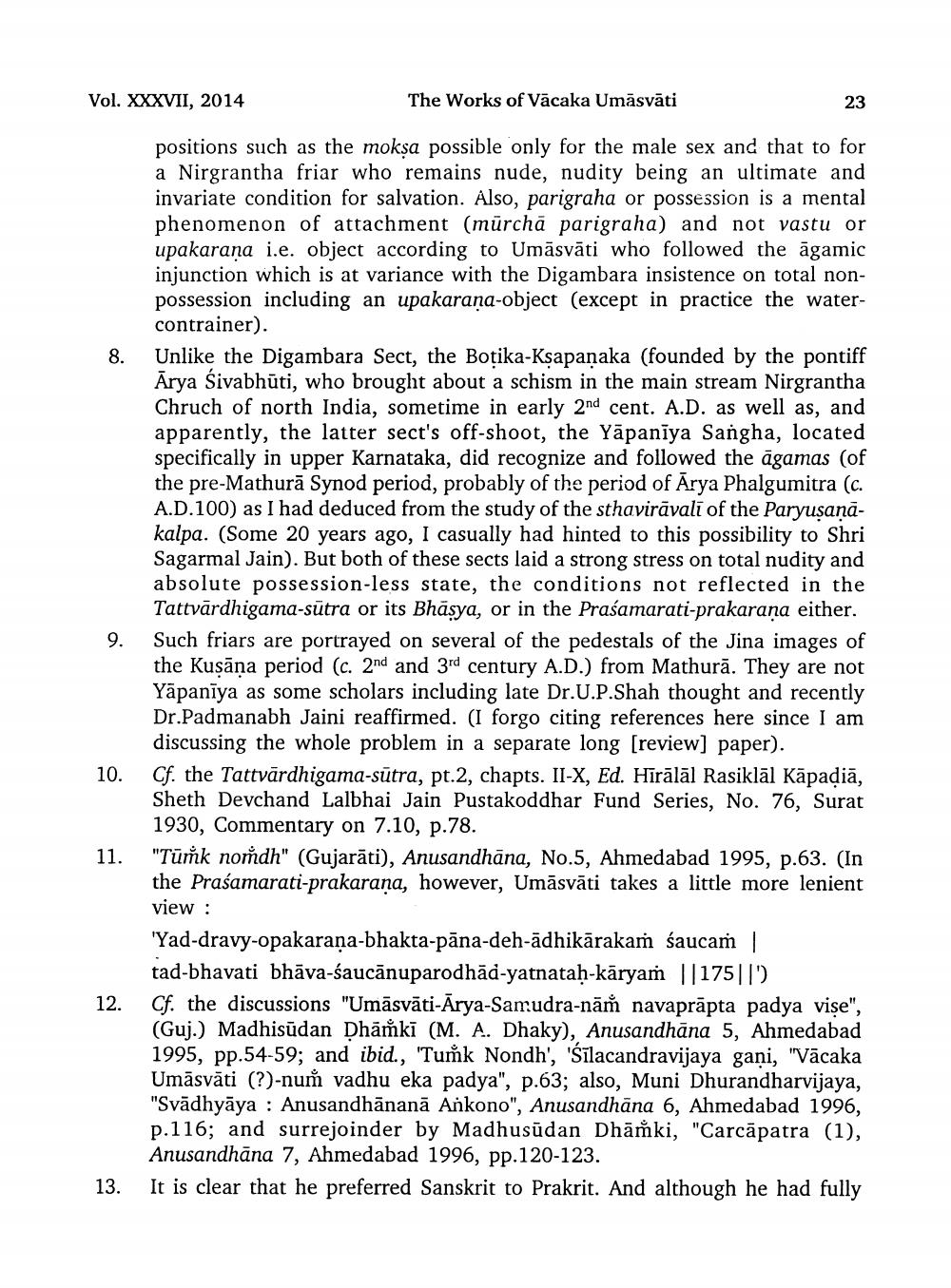________________
Vol. XXXVII, 2014
The Works of Vācaka Umāsvāti
23
9.
positions such as the mokṣa possible only for the male sex and that to for a Nirgrantha friar who remains nude, nudity being an ultimate and invariate condition for salvation. Also, parigraha or possession is a mental phenomenon of attachment (mūrchā parigraha) and not vastu or upakarana i.e. object according to Umāsvāti who followed the āgamic injunction which is at variance with the Digambara insistence on total nonpossession including an upakarana-object (except in practice the watercontrainer). Unlike the Digambara Sect, the Botika-Ksapanaka (founded by the pontiff Arya Śivabhūti, who brought about a schism in the main stream Nirgrantha Chruch of north India, sometime in early 2nd cent. A.D. as well as, and apparently, the latter sect's off-shoot, the Yāpaniya Sangha, located specifically in upper Karnataka, did recognize and followed the āgamas (of the pre-Mathurā Synod period, probably of the period of Arya Phalgumitra (c. A.D. 100) as I had deduced from the study of the sthavirāvali of the Paryusanakalpa. (Some 20 years ago, I casually had hinted to this possibility to Shri Sagarmal Jain). But both of these sects laid a strong stress on total nudity and absolute possession-less state, the conditions not reflected in the Tattvārdhigama-sūtra or its Bhāsya, or in the Praśamarati-prakarana either. Such friars are portrayed on several of the pedestals of the Jina images of the Kuşāņa period (c. 2nd and 3rd century A.D.) from Mathurā. They are not Yāpaniya as some scholars including late Dr.U.P.Shah thought and recently Dr.Padmanabh Jaini reaffirmed. (I forgo citing references here since I am discussing the whole problem in a separate long [review] paper). Cf. the Tattvārdhigama-sūtra, pt.2, chapts. II-X, Ed. Hirālāl Rasiklāl Kāpadiā, Sheth Devchand Lalbhai Jain Pustakoddhar Fund Series, No. 76, Surat 1930, Commentary on 7.10, p.78. "Tüík noṁdh" (Gujarāti), Anusandhāna, No.5, Ahmedabad 1995, p.63. (In the Praśamarati-prakarana, however, Umāsvāti takes a little more lenient view : 'Yad-dravy-opakarana-bhakta-pāna-deh-adhikārakam saucam tad-bhavati bhāva-saucānuparodhād-yatnatah-kāryam ||175||') Cf. the discussions "Umāsvāti-Arya-Samudra-nāṁ navaprāpta padya vise", (Guj.) Madhisūdan Dhāṁkī (M. A. Dhaky), Anusandhāna 5, Ahmedabad 1995, pp.54-59; and ibid., 'Tuṁk Nondh', 'Sīlacandravijaya gani, "Vācaka Umāsvāti (?)-nuṁ vadhu eka padya", p.63; also, Muni Dhurandharvijaya, "Svādhyāya : Anusandhānanā Ankono", Anusandhana 6, Ahmedabad 1996, p.116; and surrejoinder by Madhusudan Dhāṁki, "Carcāpatra (1), Anusandhāna 7, Ahmedabad 1996, pp.120-123. It is clear that he preferred Sanskrit to Prakrit. And although he had fully
10.
11.
12.
13.




